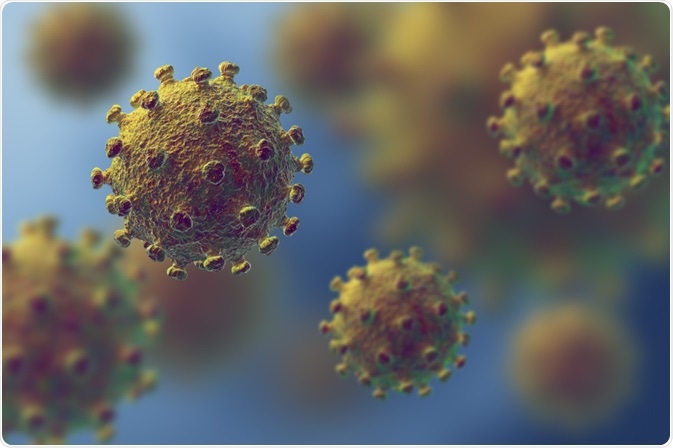Viruses can cause many important diseases which throughout history had the power to change entire countries geographically and economically as a result of sweeping infections that were impervious to known cures. For example, in the twentieth century alone, smallpox has killed an estimated 300 million individuals, whereas recent Ebola outbreaks heightened fears of a global pandemic in the 2010s. At the end of this decade, the COVID-19 pandemic realized these fears.
 Viral Particles. Image Credit: Shawn Hempel / Shutterstock.com
Viral Particles. Image Credit: Shawn Hempel / Shutterstock.com
It must be accentuated that viral infection is not always synonymous with disease, as many infections can be subclinical or asymptomatic. Conversely, others can cause disease of varying severity that is accompanied by typical clinical signs in the affected host.
The term virulence is used as a quantitative or relative measure of the ability of a virus to cause illness or death in an infected host, relative to other isolates of the same agent. This must be differentiated from infectivity or transmissibility (contagiousness) of the virus, which is not always related to it.
Pathogenesis of viral infections
In order to cause disease, viruses must first infect their host, spread to and within the target tissue, and cause damage. Transmission to other susceptible individuals is necessary to ensure their perpetuation, thus viruses developed a panoply of remarkable strategies for survival.
As viruses are obligate intracellular parasites that are transmitted as inert particles, they must attach to and infect cells at one of the body surfaces to infect the host (unless these barriers are bypassed by parenteral inoculation via a needle, a wound, or the bite of an arthropod).
The propensity of viruses to infect cells selectively in particular organs is referred to as tropism (either on cellular or organ level), which is dependent on both viral and host factors. Factors that determine whether the cell may become infected are the presence of critical receptors and the presence of required intracellular factors.
Once inside the cell, viruses use the host cell metabolism to replicate. The mechanism of viral replication varies depending on the type of the virus, but the end-goal is always the same – to produce messenger RNA molecules from which viral proteins are translated by the host cell.
Clinical disease arises due to host cell rupture and death, host cell dysfunction (including fusion with other cells to produce multinucleated giant cells), malignant transformation, and by stimulating the body’s cellular host defenses against infection. The final mechanism is responsible for a myriad of systemic symptoms associated with a viral infection, such as fever, malaise, loss of appetite, and increased mucus production.
Examples of viral diseases
Because a large number of virus genera and species exist, they are usually considered in groups. For example, respiratory syncytial virus (RSV), rhinovirus, influenza virus, and severe acute respiratory syndrome-associated coronavirus (SARS-Cov) are responsible for respiratory infections that affect the practice of respiratory care around the world.
Several virus groups are associated with gastroenteritis; they are adenoviruses, caliciviruses, astroviruses, coronaviruses, noroviruses, and rotaviruses. In infants and young children, rotaviruses represent the single most important etiological agents of acute gastroenteritis in terms of the numbers of cases and also of patients requiring admission to hospital.
Human viruses known to be spread by sexual contact include herpes simplex viruses (HSV), human papillomaviruses (HPV), human immunodeficiency virus (HIV), hepatitis B virus, as well as a plethora of other viruses. More than 80 million people have been infected with HIV since the start of the epidemic in the early 1980s.
Vaccines have influenced viral diseases in the same groundbreaking way antibiotics have affected the course of bacterial disease. They have been most successful in cases in which acute natural infection is self-limited and leads to long-lasting protective immunity if the patient survives the initial infection.
References
Further Reading